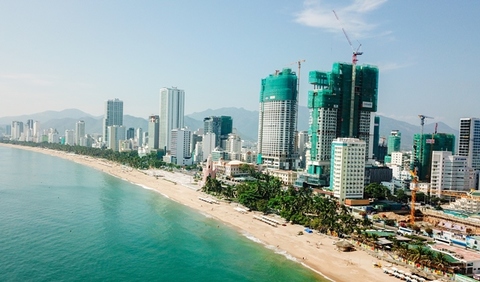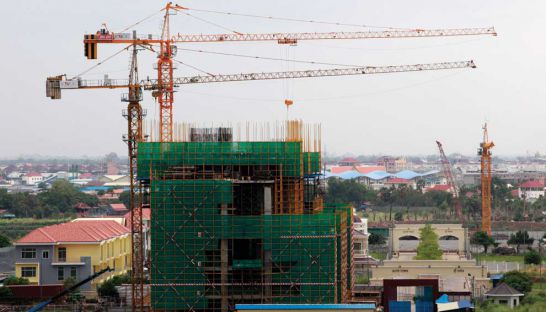The Sihanoukville MAKEOVER?
The Sihanoukville MAKEOVER?
Aiming to attract investors to broaden the Kingdom’s manufacturing base and to boost the country’s industrial development, the government is alledgedly preparing a master plan to turn Sihanoukville province into a new special economic zone, said an official.
The advisor to the Cambodian government, Dr Sok Siphana, gave a speech last week addressing the government’s plans to shape Sihanoukville province into a primary hub for trade, logistics and manufacturing. He said that while the master plan, under the responsibility of the Council for the Development of Cambodia, is set to be finalised by 2018, it needs to be carefully planned and executed.
Along with setting up a seaside special economic zone, the master plan aims to enhance the infrastructure of the country’s largest port, National Road 4 and Sihanoukville International Airport.
Siphana said that a master plan for Sihanoukville province would enhance the viability of Cambodia’s coastline.
“Usually, when it comes to industrialisation, we are talking about exporting, which means a [proper] management of the industrialization on the coast is a good thing,” he said.
These developments, he said, could help invigorate some of Cambodia’s flagging industries like agriculture.
“[For example,] the rice industry’s setback isn’t due to poor rice quality, it is due to the high price of transportation, which is why the government seeks to decrease the costs,” he said.
Last week, it was announced that an expressway between Phnom Penh and Sihanoukville will be developed to ease traffic on National Road 4. Under the Chinese firm Henan Provincial Communications Planning, Survey and Design Institute (HPCPSDI), the construction is set to begin next year and finish by 2020.
Nevertheless, Siphana acknowledged that within Cambodia’s development, the high cost of electricity is still a major impediment that needs to be addressed.
“In the new Industrial Development Policy, the government is finding a solution for the high price of electricity. By 2018, the government will have lowered the price,” he said without providing details.
While the master plan is apparently being drafted and road construction is set to begin next year, more flights to Sihanoukville International Airport have been arriving, showing an increased tourist and investor interest in Cambodia’s third largest travel destination.
Ho Vandy, the advisor to the Cambodia Chamber of Commerce and general manager of Tour World Express & Travel said that local airlines Cambodia Angkor Air and Bayon Airlines now operate daily flights connecting Sihanoukville to Siem Reap and Phnom Penh, while Sky Angkor Air land three times a week and Silk Air occasionally runs chartered flights.“This particular coastal province will only increase in potential if the government creates the [industrial] zone here because there are already existing potentials that came with the beautiful beaches and land, waterway and airway transportation,” said Vandy.
The Sihanoukville Autonomous Port (SAP), backed by an $80 million loan from the Japanese government, is also expanding to become a multi-use facility set to be completed by 2017. Last year, the port handled 60 per cent of the nation’s total goods transactions at 330,000 standard 20-foot containers, known as TEUs. The expansion would increase the ports capacity 500,000 TEUs.
These developments, along with Cambodia’s growing exports, have already attracted new activity to the Kingdom’s shipping potential. PAS has recently signed an agreement with one Chinese shipping company—China Shipping Container Lines—while another, China Ocean Shipping Group Company (COSCO) is being finalized, said Lou Kim Chhun, director general of SAP.
“This will allow us to ship imports and exports directly to China,” he said, adding that the China Shipping Containers Lines, which will use ships that can carry 1,000 TEUs, will soon be docking once a week.
“This agreement is very important, as it will decrease the price in transporting the export and import cargo into this port without having to transfer to other regional ports,” he said.
While Sung Bonna, CEO of Bonna Realty Group, said Sihanoukville already has potential and is currently meeting domestic and international market demand, he questioned if a master plan that would develop the province into a large special economic zone was warranted.
“We need to question whom we are cooperating with if we are going to turn this province into an industrial zone,” he said. “We need to make a lot of comparisons with other countries in the region to figure out what we have, and they don’t, will attract investors.”
Bonna added that although Cambodia has largely succeeded domestically, the Kingdom’s potential remains limited compared to the region. “Hence, the preparation and making of this province into an industrial zone requires an appropriate infrastructure arrangement and efficient human resources in order to attract regional investors.”















